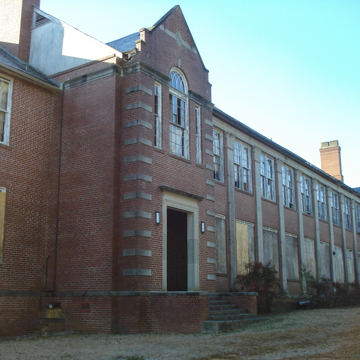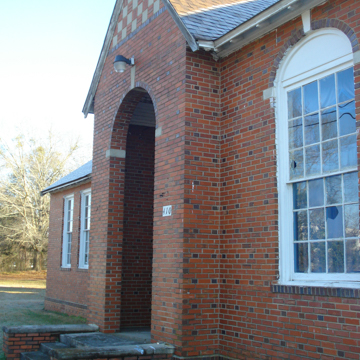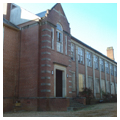Dennis High School was built for Bishopville’s African American students at the same time that Bishopville High School (1936, Henry Dudley Harrall) was built for the town’s white students. The original school was completed in 1936 and was expanded in 1954. Though Dennis High School has no known architect of record, its similarity to Bishopville High suggests that Henry Dudley Harrall assisted in its design.
Dennis High is an architectural case study of the disparities between African American and white education prevailing in early-twentieth-century South Carolina. When the Lee County school district erected these two new school buildings in the 1930s, it spent $71,000 for Bishopville High, but only $17,500 for the construction of Dennis High. The difference is obvious even on the exterior, which has far less architectural ornamentation than its counterpart in an explicit indication of a lesser commitment to African American education. Dennis High’s contractors were Edgeworth and McBride Contractors from Cheraw, South Carolina.
When it opened in 1936 Dennis High School replaced a wooden two-story building originally located about three blocks away, within Bishopville’s working class African American neighborhood. The new Dennis High was a large, three-wing brick building with an auditorium—the only auditorium for the African American community in the county. New Dennis High had more classrooms than the original school, and also had electricity. Bishopville intended this new building to serve as an elementary school, with the high school located in the original school building. But when the original school burned down in the summer of 1936, both elementary and high school students were crowded into the new building. A long, low shed of a building, Dennis High School is built of red brick and sits close to the road. At either end are two gable-roofed entrances distinguished by a checkerboard pattern in the pediment and a keystone archway. Along the street facade, the windows are similarly round-headed with keystones, a detail that marks the extent of the building’s ornamentation.
Initially, Dennis High was the only public black high school in Lee County, requiring many rural students to come to Bishopville to continue their education. The new auditorium served as a community center for plays, dances, meetings, and school programs. Dennis High was continually overcrowded until Bishopville constructed a new black high school in 1948, at which point the 1936 building became the Dennis Primary School.
In 1951, South Carolina responded to a school desegregation lawsuit by passing a sweeping school construction tax. To prove to federal courts that its schools were “separate but equal,” the state created a three percent sales tax to fund bonds for new African American schools across the state. This so-called equalization school program built new schools while also expanding and rehabilitated existing black schools. Lee County School District built a new Dennis Elementary and High School that opened in 1954, and used equalization school funds at Dennis Primary School to add a classroom and central heating, and to convert the auditorium to a cafeteria and kitchen. Lee County closed Dennis Primary School when it integrated its schools in 1970.
References
Edmonds, Michael, “Dennis High School,” Lee County, South Carolina. National Register of Historic Places Registration, 2004. National Park Service, U.S. Department of the Interior, Washington, D.C.








